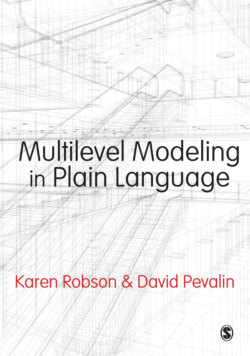Читать книгу Multilevel Modeling in Plain Language - Karen Robson - Страница 7
На сайте Литреса книга снята с продажи.
ONE What Is Multilevel Modeling and Why Should I Use It? chapter contents
ОглавлениеMixing levels of analysis 4
Theoretical reasons for multilevel modeling 6
What are the advantages of using multilevel models? 7
Statistical reasons for multilevel modeling 7
Assumptions of OLS 8Dependence among observations 8Group estimates 12Varying effects across contexts 13Degrees of freedom and statistical significance 16
Software 17
How this book is organized 19
You are probably reading this book because someone – a professor, a supervisor, a colleague, or even an anonymous reviewer – told you that you needed to use multilevel modeling. It sounds pretty impressive. It is perhaps even more impressive that multilevel modeling is known by several other names, including, but not limited to: hierarchical modeling, random coefficients models, mixed models, random effects models, nested models, variance component models, split-plot designs, hierarchical linear modeling, Bayesian hierarchical linear modeling, and random parameter models. It can seem confusing, but it doesn’t need to be.
This book is for a special type of user who is far more common than experts tend to recognize, or at least acknowledge. This book is for people who want to learn about this technique but are not all that interested in learning all the statistical equations and strange notations that are typically associated with teaching materials in this area. That is not to say we are flagrantly trying to promote bad research, because we are not. We are trying to demystify these types of approaches for people who are intimidated by technical language and mathematical symbols.
Have you ever been in a lecture or course on a statistical topic and felt you understand everything quite well until the instructor starts putting equations on the slides, and talking through them as though everyone understands them? ‘As this clearly shows … theta … gamma ….’. Have you ever been in a course where several slides of equations are used to justify and demonstrate a procedure and you just didn’t understand? Perhaps you were thinking, ‘These equations must mean something in words. Why can’t they just use the words?’ You might also just want some practical examples that are fully explained in plain language that you may be able to apply to your own research questions. If this sounds like you, then this book is for you. If you are really fond of equations, then we’re afraid that our approach in this book won’t appeal to you.
Before we get started, we also want to emphasize that this book is not about ‘dumbing down’ complicated subject matter; it’s about making it accessible. We are not endorsing using modeling techniques without understanding them. This leads to sloppy and unscientific analyses that are painful to read. What this book does is unpack these sophisticated techniques and explain them in non-technical language. We assume that you understand the principles of hypothesis testing, sampling, research design, and statistical analysis up to and including ordinary least squares regression (OLS) with interaction terms. The techniques discussed here are just extensions of regression. Really! We do try to keep the jargon to a minimum but, as with all things new, there are some new terms and phrases to get to grips with.
So, why might you have been told that you need to use multilevel modeling? The chances are that it is because your data have a ‘nested’, ‘clustered’, or ‘grouped’ structure and you are being guided to a (regression) technique that accounts for this type of data structure.
The idea of nesting, or clustering, is central to multilevel modeling. It simply means that smaller levels of analysis are contained within larger grouping units (Figure 1.1). The classic example is that individual students are nested within schools, but nesting can take other forms, such as individuals (Level 1) within cities (Level 2), patients within hospitals, siblings within families, or employees within firms.
Figure 1.1 Two-level nesting
In these types of two-level models, the lower level consisting of the smaller units (often individuals) is called Level 1, and the next level is referred to as Level 2. You may also have a third (or higher) level within which Level 2 units are nested (see Figure 1.2) such as students (Level 1) within classrooms (Level 2) within schools (Level 3), patients within hospitals within districts, siblings within families within neighbourhoods, or employees within firms within nations.
Figure 1.2 Three-level nesting
Multilevel modeling can deal with three or more levels of nesting. However, in this book we will focus on two-level models. As you gain more expertise in multilevel modeling, you may want to explore more complex structures, but for the scope of this introductory book, analysis with two levels will serve as the foundation upon which illustrative examples are created.
This book will also only consider cross-sectional nested data. There is another variation of nesting with longitudinal data. Longitudinal data are obtained when information is collected from respondents at more than one point in time. For example, people are interviewed annually in a longitudinal survey such as the British Household Panel Survey. The way nesting is conceptualized with longitudinal data is a bit different than with cross-sectional data. Data collection events (Time 1, Time 2, Time 3, etc.) are nested within individual respondents. Therefore, the time is Level 1 and the respondent is Level 2 (Figure 1.3). If your data look like this then you may still start with this book as an introduction to cross-sectional multilevel models before branching out into longitudinal data. On the positive side, there are a number of other potential techniques for analysing this type of longitudinal or panel data. Halaby (2004), for example, offers a sociologically based primer for examining issues of causality in longitudinal data. Fitzmaurice et al. (2012) have written a more detailed textbook on the topic of applied longitudinal data analysis that is targeted at a multidisciplinary audience.
Figure 1.3 Longitudinal nesting
